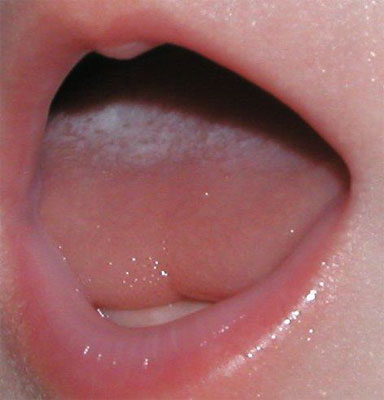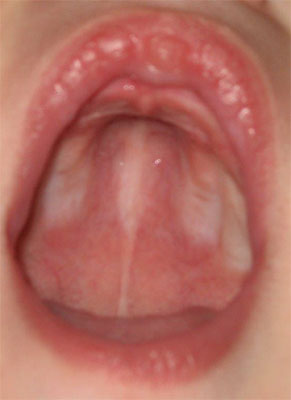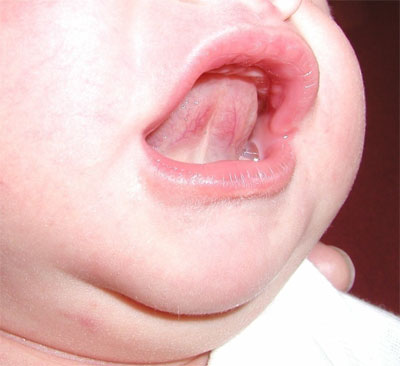

Many parents are concerned that their baby may be tongue-tied. Many breastfeeding problems are blamed on tongue-tie. Almost everyone has a lingual frenulum, or bit of tissue under the tongue that helps connect the tongue to the floor of the mouth. The most important thing is that the tongue can move properly.
Most breastfeeding problems are caused by misunderstanding what babies need. Help with positioning and latch is the first step to improving breastfeeding. LLL meetings, LC consultations, breastfeeding or baby cafés are all good resources for getting individualized help.
Some tongue-tied babies can make breastfeeding work. Even if your baby has an obvious tongue-tie, first get help from a lactation professional.
Most professionals agree that a tight frenulum that attaches to the tip of the tongue can make it more difficult for babies to feed. These tongue-ties can be easy to treat in a doctor or dentist’s office. Figure 3 shows a very tight frenulum that experts agree needs treatment.
There is more controversy about babies who do not have good tongue mobility but do not have a tight frenulum at the front of the tongue. New anatomy research suggests that tight fascia (the soft tissue that joins body structures) may be responsible. Depending on the cause of the tightness, therapy may be the best option. Physical therapy is best studied for neck muscle imbalances caused by the baby’s position during pregnancy, other body work may be helpful as well.
Here’s how you can look at your own baby’s tongue movements:
The first thing to assess is whether your baby can stick out his or her tongue. If you touch your baby's lips, he will probably open his mouth. You can then touch the front of his lower gum with your fingertip. This makes him stick the tongue out. We want to see the tongue come out flat over the lip without denting or dimpling.

Next, we want to see if your baby can lift her tongue way up to the roof of the mouth. All the way up is perfect, half way is enough for most babies to be able to breastfeed. Again, her mouth should be open when you check if the tongue can lift up.

Tongue-ties:
This baby (figure 3) has an obvious tongue-tie. You can see the membrane right at the front of the tongue, and you can see how it makes it hard for him to lift his tongue up.

Babies with a tight frenulum may have a notch in the tip of the tongue when they try to move the tongue (figure 4). This is also called a "heart-shaped" tongue. Some babies have a notch but can still lift the tongue normally. Remember we want to look at the whole baby and not just one feature.

Babies with a tongue-tie will often raise the sides of the tongue while the front of the tongue pulls downward toward the floor of the mouth. Professionals call this a "low tongue posture". See (figure 5)

Babies with restricted or weak tongue movements will have a high, narrow roof of the mouth (figure 6). This is an important "double check" or confirmation that the tongue is not moving well. There are other reasons to have a high or narrow palate too, such as being in a position during development that prevented the baby's head from expanding side to side.

Having a shorter lower jaw than average can affect tongue strength. This baby (figure 7) does NOT have a tongue-tie. Dividing the frenulum when the real reason for sucking problems is a short jaw or muscle tightness in the face or neck will not help and can often make the problem worse.

Again, if your baby does seem to be tongue-tied, please get lactation help first. Some tongue-tied babies are able to breastfeed without treatment with some special help latching on. An IBCLC should also be able to help determine whether a breastfeeding problem is from a tongue tie or is from poor latch or positioning, a short jaw or tight muscles and communicate these findings with your baby's primary health care provider.

